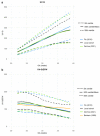Umbilical Vein Blood Flow in Uncomplicated Pregnancies: Systematic Review of Available Reference Charts and Comparison with a New Cohort
- PMID: 37176573
- PMCID: PMC10179232
- DOI: 10.3390/jcm12093132
Umbilical Vein Blood Flow in Uncomplicated Pregnancies: Systematic Review of Available Reference Charts and Comparison with a New Cohort
Abstract
The objectives of the study were (1) to perform a systematic review of the available umbilical vein blood flow volume (UV-Q) reference ranges in uncomplicated pregnancies; and (2) to compare the findings of the systematic review with UV-Q values obtained from a local cohort. Available literature in the English language on this topic was identified following the PRISMA guidelines. Selected original articles were further grouped based on the UV sampling sites and the formulae used to compute UV-Q. The 50th percentiles, the means, or the best-fitting curves were derived from the formulae or the reported tables presented by authors. A prospective observational study of uncomplicated singleton pregnancies from 20+0 to 40+6 weeks of gestation was conducted to compare UV-Q with the results of this systematic review. Fifteen sets of data (fourteen sets belonging to manuscripts identified by the research strategy and one obtained from our cohort) were compared. Overall, there was a substantial heterogeneity among the reported UV-Q central values, although when using the same sampling methodology and formulae, the values overlap. Our data suggest that when adhering to the same methodology, the UV-Q assessment is accurate and reproducible, thus encouraging further investigation on the possible clinical applications of this measurement in clinical practice.
Keywords: Doppler ultrasound; fetus; nutrition; oxygenation; reference ranges; reproducibility; umbilical cord; umbilical vein blood flow volume.
Conflict of interest statement
The authors declare no conflict of interest.
Figures






References
Publication types
LinkOut - more resources
Full Text Sources

